Femenias Findings: Exploring the Link Between Camp Mills and the “Mayan Ruins” Motor Parkway Bridge

Frank Femenias believes there may be a link between the short-life of the Camp Mills (1918-1919) and the reason the nearby "Mayan Ruins"Motor Parkway Bridge was never completed. Did Frank convince you with these amazing overlays?
Enjoy,
Howard Kroplick
Frank Femenias:
Noticing the proximity of the Mayan Ruins abutments to Camp Mills Base Hospital, I couldn’t resist to create an overlay using the 1926 aerial Cheryl Lynn Blum submitted.
Hospital Road, once running adjacent to the Motor Parkway, terminated right at the foot of the never-built bridge. The aerial also reveals how many walked through dirt paths to cross the parkway at the southern end of the abutments. And though barely visible in the photograph, I can still faintly read the year 1913 or 1917 on the abutment sign.
Could it be the bridge was never built because of the hospital’s short life span 1918-1919?
Source: U.S. Army Medical Department-Military Hospitals
BASE HOSPITAL, CAMP MILLS, LONG ISLAND, N. Y.
The base hospital at Camp Mills was situated in Nassau County, Long Island, N. Y., about 10 miles from the eastern boundary of Greater New York, and 1 mile, to the east, from Mineola.
The terrain is practically flat. The soil is a sandy loam in which there is a small amount of gravel. It readily pulverizes in dry weather, forming easily carried dust, and becomes a tenacious mud after rains.
The climate is moderate during the greater portion of the year. In the winter there is an occasional severely cold spell; the spring and fall are delightful; and during the summer about two or three weeks only might be considered uncomfortably warm.
Camp Mills was selected as a mobilization camp for the Rainbow Division (42nd), so called, because the sources of its component elements were geographically diversified. The division assembled in the early part of September, 1917; and, after a training period of one and one-half months, embarked for France. Because it was known that this division would remain but a short time in the United States, and that the subsequent mobilization of divisions was an uncertainty, no cantonment type of base hospital was constructed at Camp Mills at this time. A camp hospital, composed of a few existing buildings and of tentage mostly, was organized for the care of the sick of the 42nd Division.
The organized camp hospital remained at Camp Mills, upon the departure of the 42nd Division, to care for the sick of that command whom it was necessary to leave in the United States. It was fortunate that the hospital was in existence, for on October 26, 1917, the 41st Division was ordered from Camp Greene, N. C., to Camp Mills, with the view to its embarkation for France within a short period.
In the general description of the conditions of the various embarkation and debarkation hospitals at the port of Hoboken, it was related how, because of the total inadequacy of the cluster of hospital tents for the care of the sick of the 41st Division at Camp Mills, supervisory control of the hospital at that camp was given to the port surgeon, Hoboken, and how relief from the situation was had by transferring selected patients to civil hospitals in New York City and on Long Island.
It was not until April 6, 1918, that a base hospital was organized. At this time Evacuation Hospital No. 4 was sent to Camp Mills from Camp Crane, Allentown, Pa., and it was utilized in the establishment of a base hospital.
The fair grounds at Mineola contained 6 cattle sheds, 1 poultry house, 1 grand stand, 5 exhibition buildings, 2 small houses for the storage of paint, and the stables. These buildings were occupied by Evacuation Hospital No. 4 on April 9, 1918.
The stables were utilized for quarters for officers. The nurses were domiciled in houses in Mineola, rented by the Quartermaster Corps. The enlisted men were quartered partly in the stables and partly in tents.
a The statements of fact appearing herein are based on the "History, Base Hospital, Camp Mills, Long Island," by Lieut. Col. A. W. Cutler, M. C., U.S.A., while on duty as a member of the staff of that hospital. The material used by him in the compilation of the history comprised official reports from the various divisions of the hospital. The history is on file in the Historical Division, Surgeon General's Office, Washington, D. C.-Ed.
The hospital mess was at first located in the poultry house. This arrangement was found to be very unsatisfactory, and the lower portion of the grand stand was converted into a kitchen and mess hall, where the enlisted men and ambulatory patients ate. The officers of the organization maintained their own mess in the stables, using the broad isle between the stalls-the sleeping compartments-for a dining hall.
There were no storehouses, so tents and sheds were used in which to store the supplies.
The water supply was derived from Mineola. Its source was artesian wells, and the quality of the water was so excellent as to require no purification treatment.
A sewerage system was constructed so as to connect the various buildings of the fairgrounds with a main sewer, the outlet of which was a small sewage-disposal plant on the grounds. Each cow shed contained two toilet bowls, and each exhibition building had five.
The garbage from the hospital was disposed of to local farmers, who made collections twice daily.
On May 6, 1918, the construction of a surgical pavilion was begun. This building comprised seven rooms and some linen closets, and was planned to house not only the surgical activities, but the eye, ear, nose and throat, X-ray, dental, and genitourinary departments. It was ready for occupancy June 15, 1918, but could not be utilized for surgical operations until later, because of the lack of equipment.
On September 16, 1918, the constructing quartermaster received authority to construct a semipermanent 2,000-bed base hospital. A site was selected northwest of Camp Mills and just to the east of the fairgrounds. Work on the construction of the hospital was rapidly pushed, and the first 600 beds were ready for occupancy on October 26, 1918. The entire group of buildings was completed by February 1, 1919.
The arrangement of the buildings conformed to the ultimate block plan designed in the office of the Surgeon General-block plan E, Figure 13. Each building was two-storied, and, because of the close proximity to one another, were made of fire-resisting material-metal lath with stucco covering.
On September 18, 1919, there being no further use for it, the base hospital was abandoned.
Statistical data, United States Army Base Hospital, Camp Mills, Mineola Long Island, N. Y., from April 6, 1918, to September 18, 1919, inclusive.
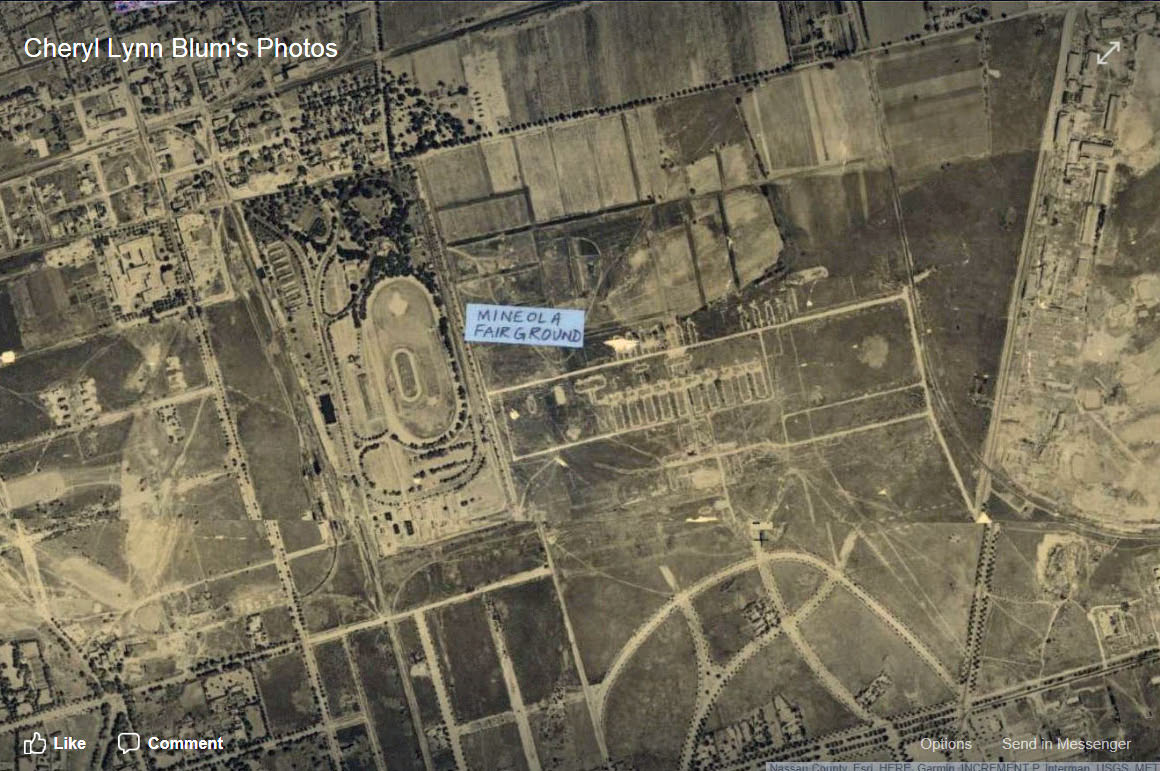
1926 Garden City aerial submitted by Cheryl Lynn Blum.
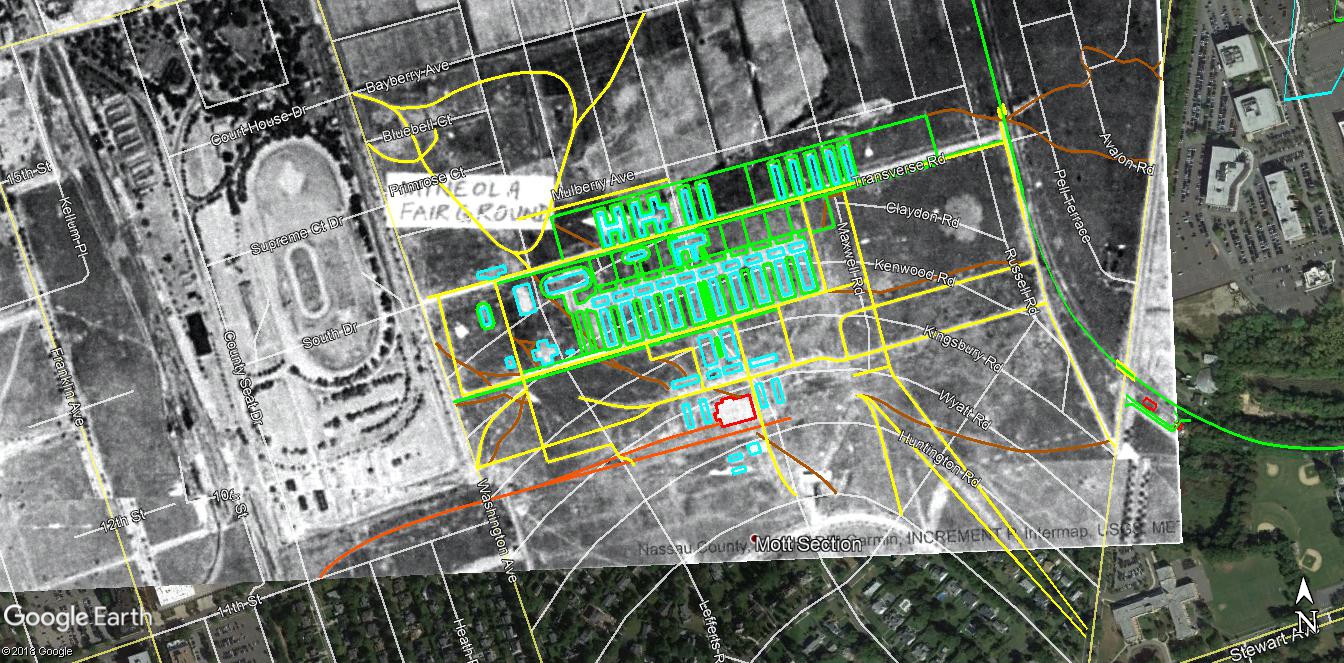
1926 Camp Mills Base Hospital
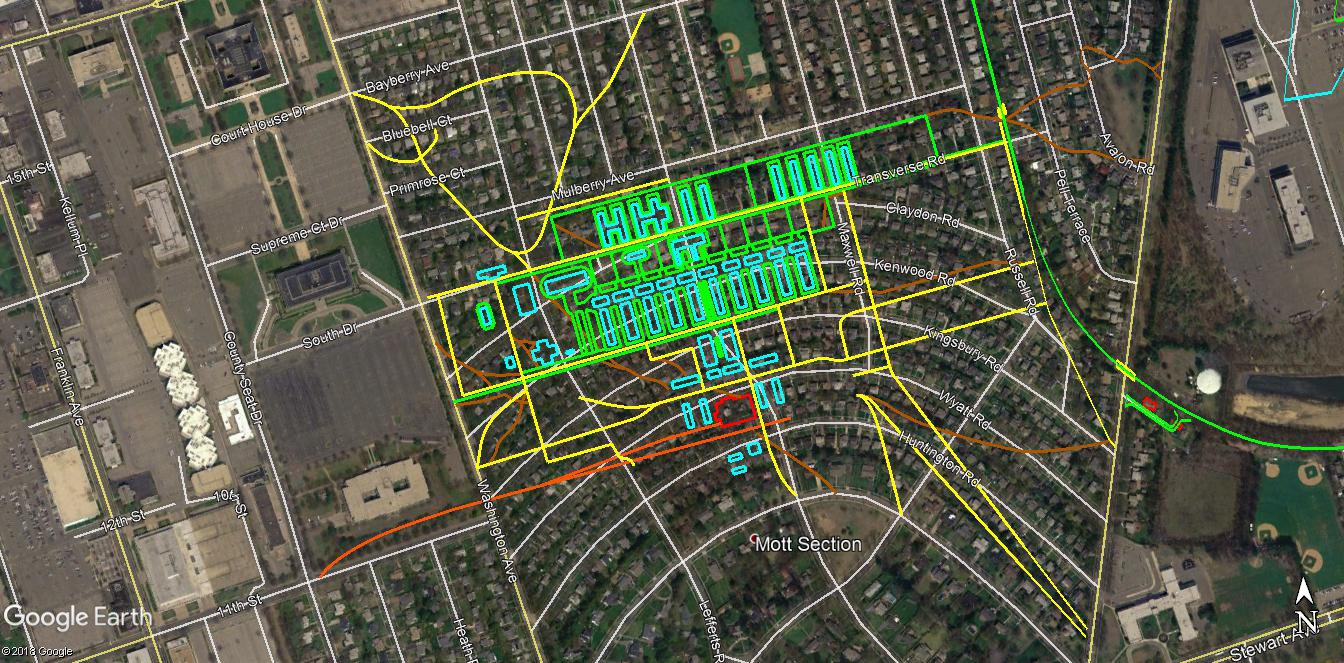
1926 Camp Mills Base Hospital
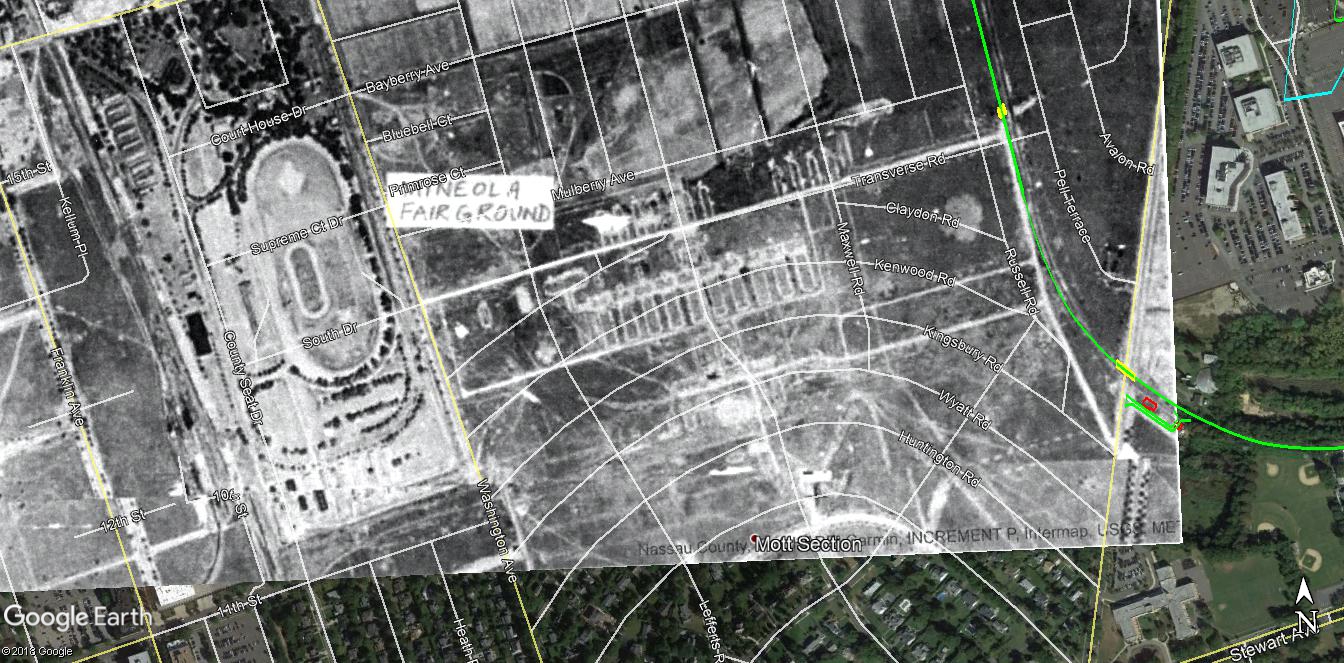
1926 Camp Mills Base Hospital Overlay
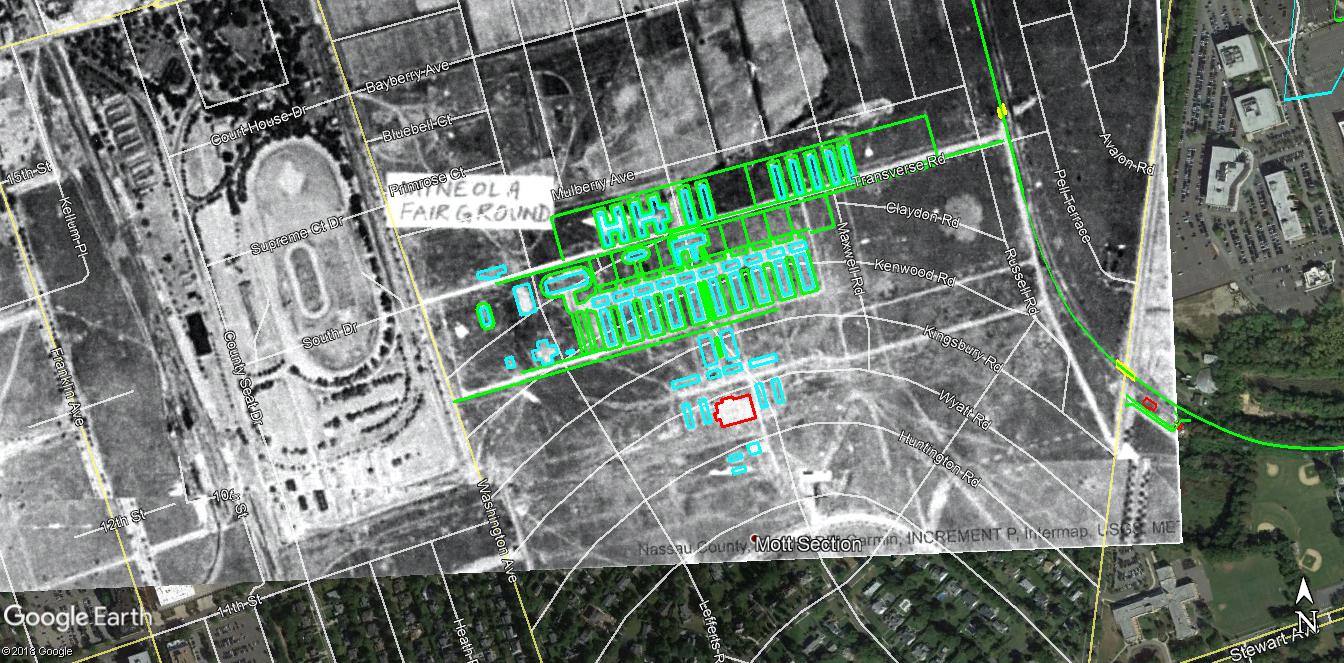
1926 Camp Mills Base Hospital Buildings
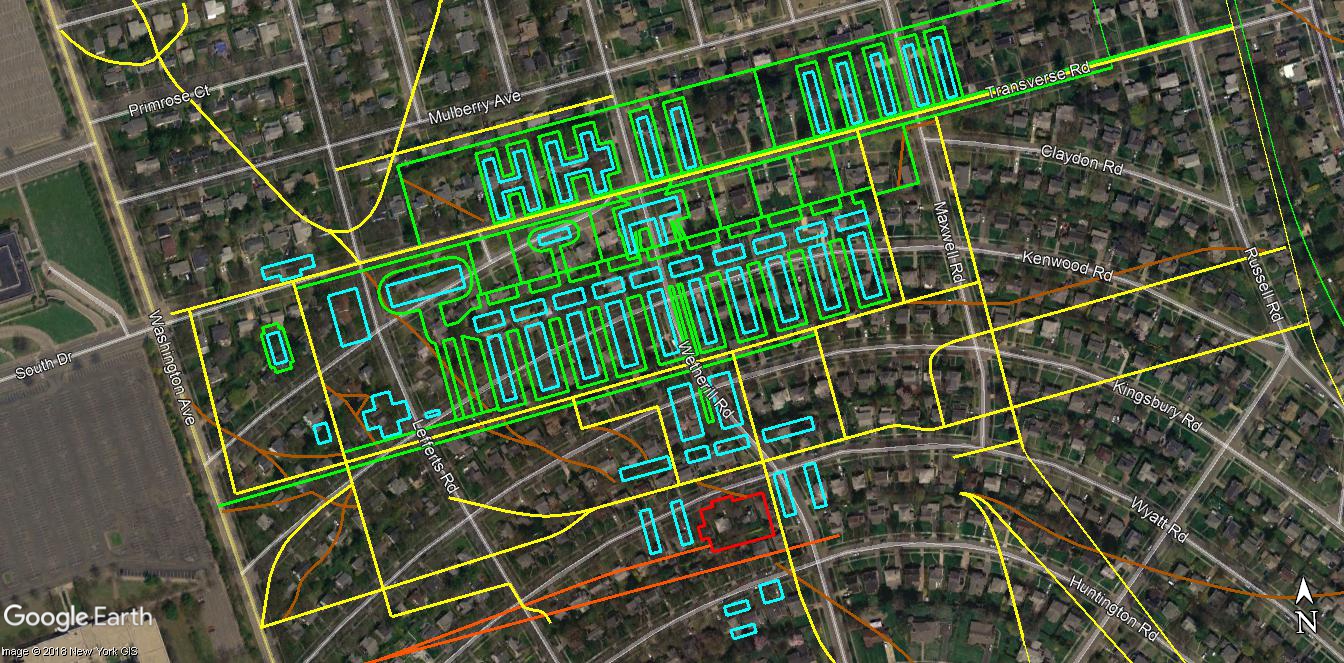
1926 Camp Mills Base Hospital Buildings-Zoomed
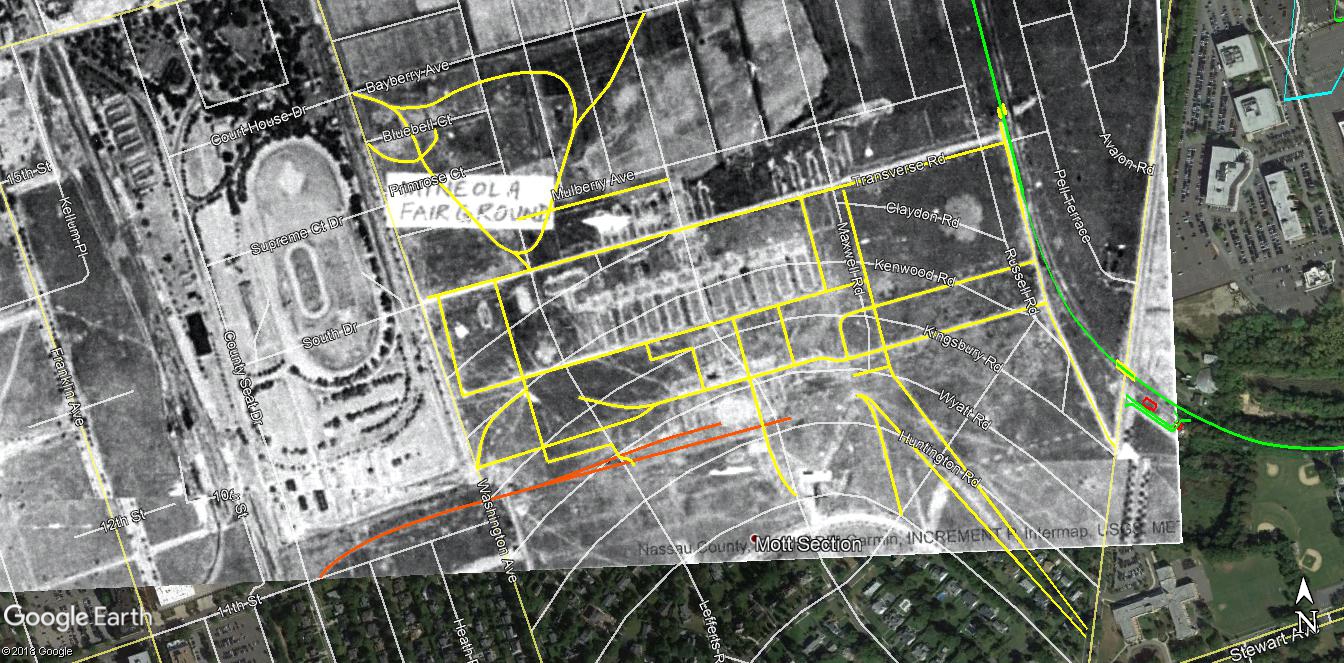
1926 Camp Mills Base Hospital Roadways and RR Spur
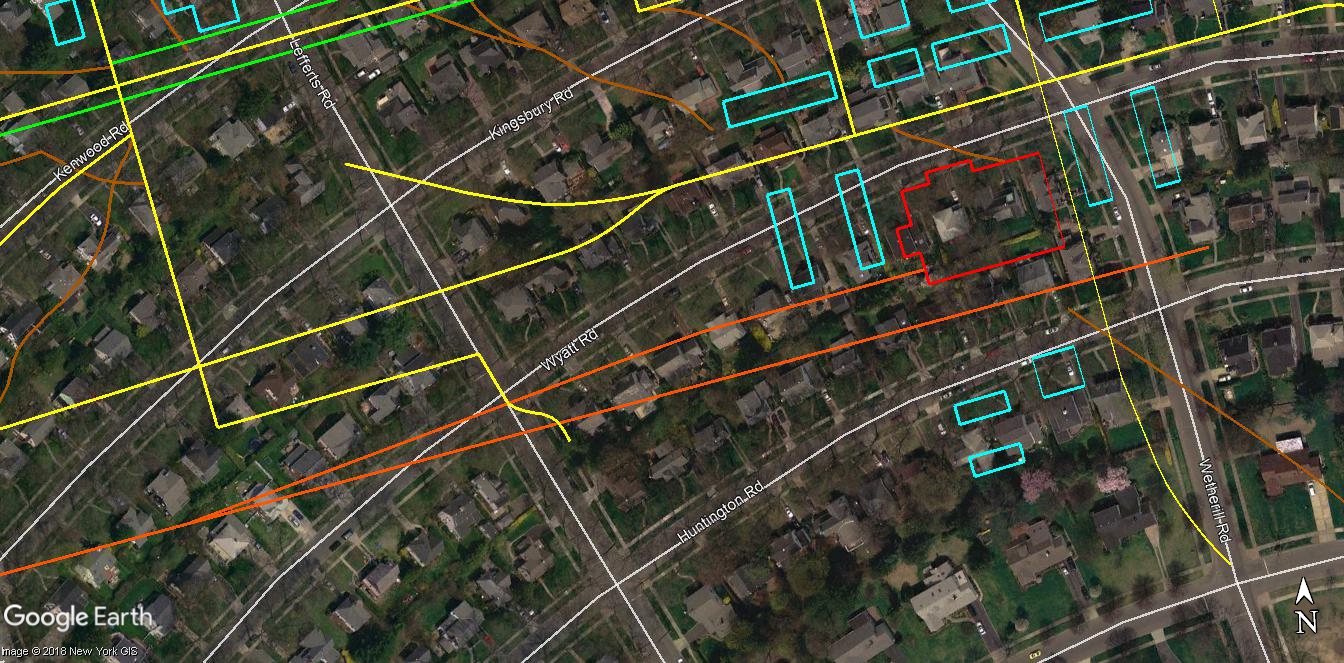
1926 Camp Mills Base Hospital Powerhouse and RR Spur -Zoomed
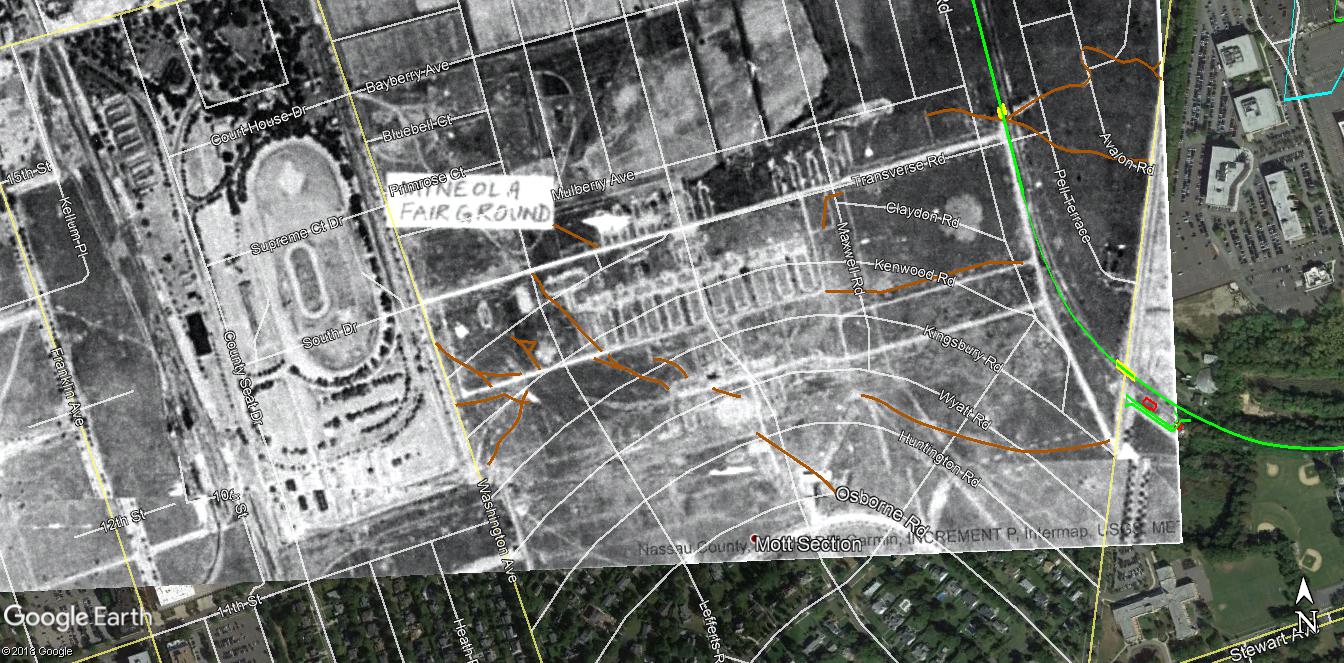
1926 Camp Mills Base Hospital Dirt Walk Paths
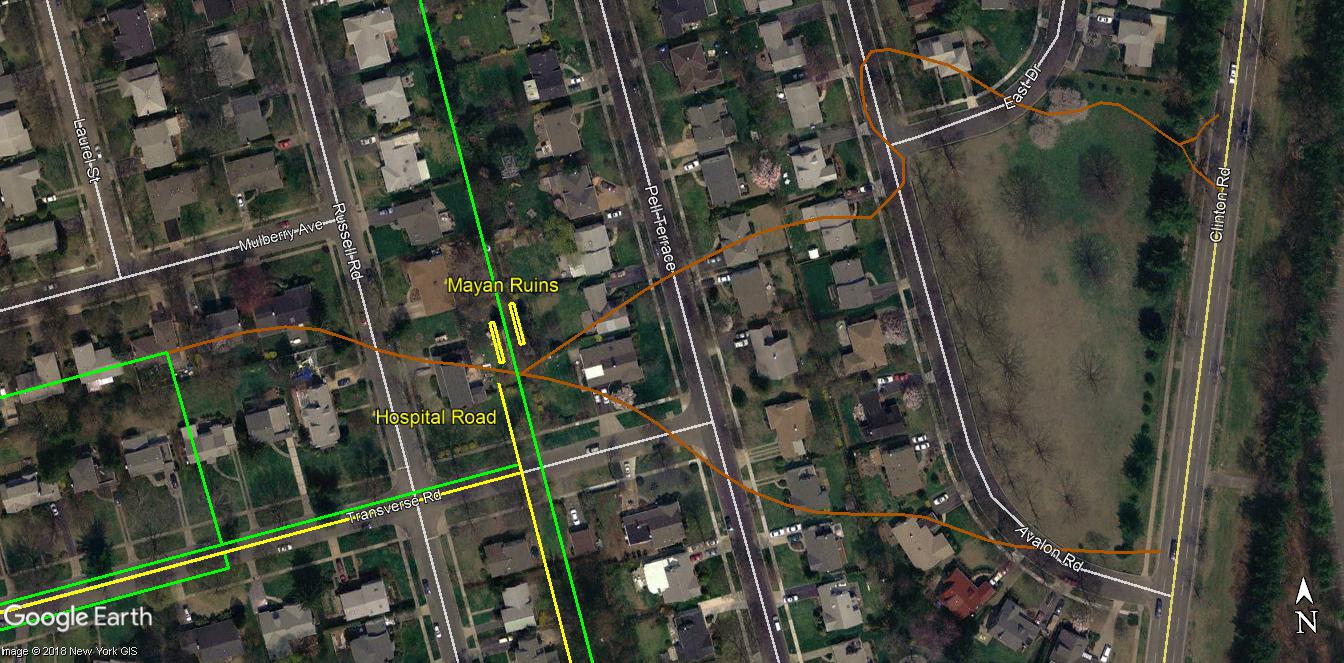
1926 Camp Mills Base Hospital Crossing the Motor Parkway- Zoomed
The Unfinished "Mayan Ruins" Bridge
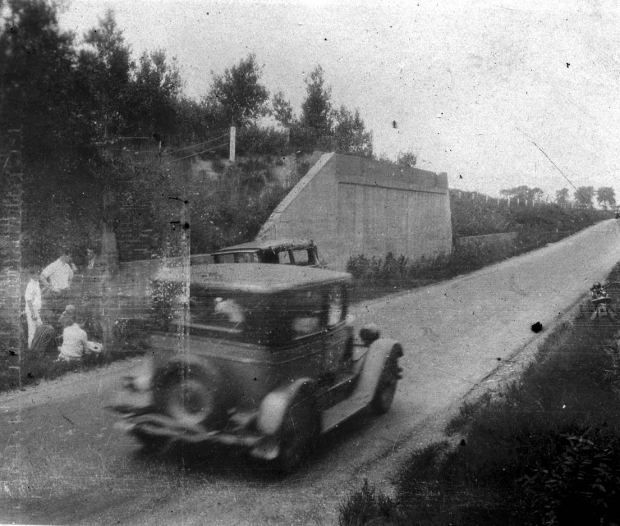
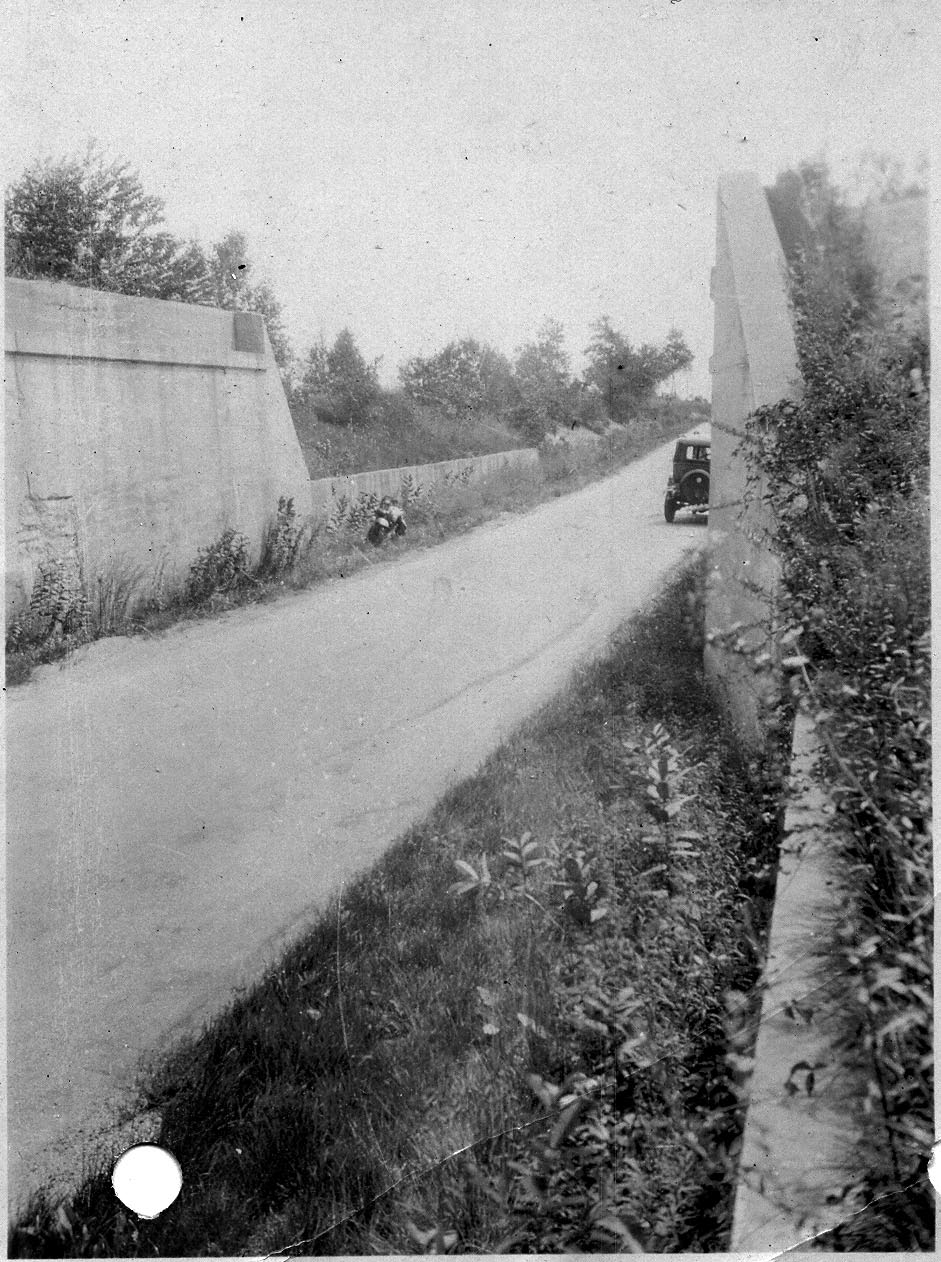

Comments
This theory has been in the back of my mind ever since Howard was wondering, and now Frank. I can definitely envision a proposed road angling from the NE, following the unfinished bridge; and merging with Transverse Rd. Wish I could make out the years that you see, Frank; on the sign/plaque that’s mounted on the west abutment. Year 1917 would be the right time period. Your mapping is excellent as usual, Frank.
Remember Mr. Bellmer stating that Transverse Rd. was carved out specifically for the Base Hospital ( presumably Hospital Rd. as well ). You have access from Washington Ave., and I’m guessing that Hospital Rd. connected with Clinton Rd. or Stewart Ave.
Howard…You have a Garden City Company Survey Map of a proposed subdivision on the 9/28/2010 Blog: Part 1: The Motor Parkway “Mayan Ruins”. The survey displays a convincing planned road that curves south from Clinton Rd, then west across the LIMP; following the unfinished “Mayan Ruins” overpass. Do you happen to know the year of this survey map? Brian
Wow Frank. I’m impressed. Your cartography skills are amazing.
Nice Job it makes perfect sense that bridge would have serviced the hospital from the airport at Mitchel Field .
Great work but -.. The Transverse Road abutments are dated 1911 or so and WWI wasn’t even a glimmer on the horizon, let alone any Camp Mills or a base hospital for the 42d! An I recall me aright, the Transverse Road bridge was required as a condition of the conveyance of the surrounding land to the LIMP and the provision (as with several other such planned bridges) was never enforced. The company used every trick in the book to avoid constructing anything it could get away without. Mayhap we need Al’s scholarship here. Sam, III
Driving my bicycle last week near Mayan Ruins noticed two new houses on corner of Transverse and Russell Rd, Garden City. The house where the Mayan Ruins stood has been knocked down. In its place there are two new houses. The contractors must have knocked down the west side the old concrete embankment of the Mayan Ruins.
I took photos but can’t upload to this website. Andy
Howard, could the Mayan Ruins be the start of a railroad-type trestle bridge? I note the abutment walls, the width of the cross-section, and the alignment of the right-of-way fence posts, all suggestive of that bridge type to me, but others might know better. A trestle bridge in an area where no roads or paths had previously existed in USGS maps as far back as the 1890s would be consistent to an Army/Camp Mills link.
Andy Ward - Please send any photos of the new Mayan Ruins and nearby location to Howard at - .(JavaScript must be enabled to view this email address). Those photos would be most interesting. Thanks!
Sorry, folks; it won’t fadge! Rank revisionism. The abutments predate all the Mills bit. Al, where are you when we need you? To David’s query, the abutments, which are quite close together, appear perfectly normal for the usual LIMP plate girder bridge, not any special trestle. When I was first in there and the abutments were more visible, I saw nothing out of the ordinary about them. If the base hospital had progressed further, a bridge certainly might have been considered but that’s pure speculation so far. Sam, III